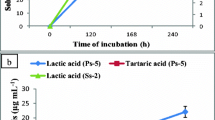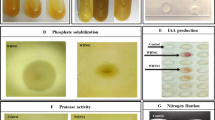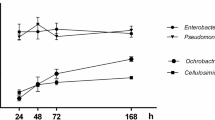Abstract
Plant growth–promoting rhizobacteria are under extensive investigation to supplement the chemical fertilizers due to cost-effective and eco-friendly nature. However, their consistency in heterogeneous soil and diverse ecological settings is unclear. The current study presents in vitro and field evaluation of pre-characterized PGPR strain Enterobacter sp. Fs-11 (GenBank accession # GQ179978) in terms of its potential to enhance sunflower yield and oil contents under diverse environmental conditions. Under in vitro conditions, strain Fs-11 showed optimal growth at a range of temperature (15 to 40 °C) and pH values (6.5 to 8.5). Extracellular and intracellular localizations of the strain Fs-11 in sunflower root cortical cells through transmission electron microscopy confirmed its epiphytic and endophytic colonization patterns, respectively. In field experiments, conducted at three different agro-climatic locations, inoculation of strain Fs-11 at 50% reduced NP fertilizer resulted in a significant increase in growth, achene yield, nutrient uptake, and oil contents. Inoculation also responded significantly in terms of increase in mono- and polyunsaturated fatty acids (oleic and linoleic acids, respectively) without rising saturated fatty acid (palmitic and stearic acids) contents. We concluded that Enterobacter sp. Fs-11 is a potential candidate for biofertilizer formulations to supplement chemical fertilizer requirements of sunflower crop under diverse climatic conditions.




Similar content being viewed by others
References
Singh JS, Pandey VC, Singh DP (2011) Efficient soil microorganisms: a new dimension for sustainable agriculture and environmental development. Agric Ecosyst Environ 140:339–353
Buée M, De Boer W, Martin F et al (2009) The rhizosphere zoo: an overview of plant-associated communities of microorganisms, including phages, bacteria, archaea, and fungi, and of some of their structuring factors. Plant Soil 321:189–212
Bhattacharyya PN, Jha DK (2012) Plant growth-promoting rhizobacteria (PGPR): emergence in agriculture. World J Microbiol Biotechnol 28:1327–1350
Pérez-Montaño F, Alías-Villegas C, Bellogín R et al (2014) Plant growth promotion in cereal and leguminous agricultural important plants: from microorganism capacities to crop production. Microbiol Res 169:325–336
Akram MS, Tariq M, Shahid M et al (2016) Deciphering Staphylococcus sciuri SAT-17 mediated anti-oxidative defense mechanisms and growth modulations in salt stressed maize (Zea mays L.). Front Microbiol 7:867
Kaymak HC (2011) Potential of PGPR in agricultural innovations. In: Maheshwari DK (ed) Plant growth and health promoting bacteria. Springer, Berlin, pp 45–79
Tailor AJ, Joshi BH (2014) Harnessing plant growth promoting rhizobacteria beyond nature: a review. J Plant Nutr 37:1534–1571
Mahmood F, Shahid M, Hussain S, Shahzad T, Tahir M, Ijaz M, Hussain A, Mahmood K, Imran M, Babar SAK (2017) Potential plant growth-promoting strain Bacillus sp. SR-2-1/1 decolorized azo dyes through NADH-ubiquinone: oxidoreductase activity. Bioresour Technol 235:176–184
Majeed A, Abbasi MK, Hameed S et al (2015) Isolation and characterization of plant growth-promoting rhizobacteria from wheat rhizosphere and their effect on plant growth promotion. Front Microbiol 6:198
Lucas J, Solano BR, Montes F et al (2009) Use of two PGPR strains in the integrated management of blast disease in rice (Oryza sativa) in southern Spain. Field Crops Res 114:404–410
Shahid M, Hameed S, Imran A, Ali S, van Elsas JD (2012) Root colonization and growth promotion of sunflower (Helianthus annuus L.) by phosphate solubilizing Enterobacter sp. Fs-11. World J Microbiol Biotechnol 28:2749–2758. https://doi.org/10.1007/s11274-012-1086-2
Shahid M, Hameed S, Tariq M, Zafar M, Ali A, Ahmad N (2015) Characterization of mineral phosphate-solubilizing bacteria for enhanced sunflower growth and yield-attributing traits. Ann Microbiol 65:1525–1536. https://doi.org/10.1007/s13213-014-0991-z
Qaisrani MM, Mirza MS, Zaheer A et al (2014) Isolation and identification by 16s rrna sequence analysis of Achromobacter, Azospirillum and Rhodococcus strains from the rhizosphere of maize and screening for the beneficial effect on plant growth. Pak J Agric Sci 51:91–99
Shoda M (2000) Bacterial control of plant diseases. J Biosci Bioeng 89:515–521
Ashrafuzzaman M, Hossen FA, Ismail MR et al (2009) Efficiency of plant growth-promoting rhizobacteria (PGPR) for the enhancement of rice growth. Afr J Biotechnol 8:1247–1252
Rodriguez H, Fraga R (1999) Phosphate solubilizing bacteria and their role in plant growth promotion. Biotechnol Adv 17:319–339
Podile AR, Kishore GK (2006) Plant growth-promoting rhizobacteria. In: Gnanamanickam SS (ed) Plant-associated bacteria. Springer, Netherlands, pp 195–230
Kucey RMN, Janzen HH, Leggett ME (1989) Microbially mediated increases in plant-available phosphorus. Adv Agron 42:199–228
Stefan M, Mihasan M, Dunca S (2008) Plant growth promoting rhizobacteria can inhibit the in vitro germination of Glycine max L. seeds. Analele Stiintifice ale Universitatii “Al. I. Cuza” Din Iasi.(Serie Noua). Sectiunea 2. a. Genetica si Biologie Moleculara 9(3):105–110
Pii Y, Mimmo T, Tomasi N, Terzano R, Cesco S, Crecchio C (2015) Microbial interactions in the rhizosphere: beneficial influences of plant growth-promoting rhizobacteria on nutrient acquisition process A review. Biol Fertil Soils 51:403–415. https://doi.org/10.1007/s00374-015-0996-1
Bashan Y, de-Bashan L, Prabhu S, et al. Advances in plant growth-promoting bacterial inoculant technology: formulations and practical perspectives (1998–2013). Plant Soil 2014;378:1–33
Gamalero E, Berta G, Glick BR (2009) The use of microorganisms to facilitate the growth of plants in saline soils. In: Khan MS, Zaidi A, Musarrat J (eds) Microbial strategies for crop improvement. Springer Verlag, Berlin, pp 1–22
Ahemad M, Kibret M (2014) Mechanisms and applications of plant growth promoting rhizobacteria: current perspective. J King Saud Univ 26:1–20
Zaidi A, Khan M, Ahemad M, Oves M (2009) Plant growth promotion by phosphate solubilizing bacteria. Acta Microbiol Immunol Hung 56:263–284
Glick BR (2012) Plant growth-promoting bacteria: mechanisms and applications. Scientifica 2012:1–15. https://doi.org/10.6064/2012/963401
Sharma S, Sayyed R, Trivedi M et al (2013) Phosphate solubilizing microbes: sustainable approach for managing phosphorus deficiency in agricultural soils. SpringerPlus 2:587
Khan A, Iqbal M, Ahmad I et al (2000) Effect of different water stress levels on yield and oil content of sunflower (Helianthus annuus L.) cultivators. Pak J Biol Sci 3(10):1632–1633
Somasegaran P, Hoben HJ (1994) Handbook for rhizobia: methods in legume-rhizobium technology. Springer-Verlag, Berlin
Ali I, Barrientos A, Saboor A (2015) Pro-poor growth across different agro-climatic zones of rural Pakistan. Pak J Agric Sci 52:495–501
Yoshida S, Forno DA, Cock JH (1976) Laboratory manual for physiological studies of rice. Philippines: Los Banos; 61
Sparks DL, Page AL, Helmke PA et al (1996) Methods of soil analysis: part 3-chemical methods. Soil Science Society of America, Washington DC
Erickson DR (1980) Handbook of soy oil processing and utilization. In: Erickson DR, Pryde EH, Brekke OL, et al. eds. American Soybean Association St. Louis and American Oil Chemists Society champaign. St. Louis, Missouri and Champaign
Steel RGD, Torrie JH, Dickey DA (1997) Principles and procedures of statistics: a biometrical approach, 3rd edn. McGraw-Hill, New York
Pandey A, Dhakar K, Sharma A et al (2014) Thermophilic bacteria that tolerate a wide temperature and pH range colonize the Soldhar (95°C) and Ringigad (80°C) hot springs of Uttarakhand, India. Ann Microbiol 65:809–816
Schloter M, Wiehe W, Assmus B et al (1997) Root colonization of different plants by plant-growth-promoting Rhizobium leguminosarum bv. trifolii R39 studied with monospecific polyclonal antisera. Appl Environ Microbiol 63:2038–2046 DOI 0099–2240/97/$04.0010
Hameed S, Mubeen F, Malik KA, Hafeez FY (2005) Nodule co-occupancy of Agrobacterium and Bradyrhizobium with potential benefit to legume host. In: Wang YP (ed) Biological nitrogen fixation, sustainable agriculture and the environment. Springer, The Netherlands, pp 295–296
Jeun YC, Lee YJ, Kim KW, Kim SJ, Lee SW (2008) Ultrastructures of Colletotrichum orbiculare in the leaves of cucumber plants expressing induced systemic resistance mediated by Glomus intraradices BEG110. Mycobiology 36:236–241. https://doi.org/10.4489/MYCO.2008.36.4.236
Yasmeen T, Hameed S, Tariq M et al (2012) Vigna radiata root associated mycorrhizae and their helping bacteria for improving crop productivity. Pak J Bot 44:87–94
Chaudhry Q, Rasul G (2004) Agroclimatic classification of Pakistan. Science Vision 9:59–66
Igual JM, Valverde A, Cervantes E, Velázquez E (2001) Phosphate-solubilizing bacteria as inoculants for agriculture: use of updated molecular techniques in their study. Agronomie 21:561–568
Chen YP, Rekha PD, Arun AB, Shen FT, Lai WA, Young CC (2006) Phosphate solubilizing bacteria from subtropical soil and their tricalcium phosphate solubilizing abilities. Appl Soil Ecol 34:33–41
Shirmardi M, Savaghebi GR, Khavazi K et al (2010) Effect of microbial inoculants on uptake of nutrient elements in two cultivars of sunflower (Helianthus annuus L.) in saline soils. Not Sci Biol 2:57–66
Andreote FD, De Araújo WL, De Azevedo JL et al (2009) Endophytic colonization of potato (Solanum tuberosum L.) by a novel competent bacterial endophyte, Pseudomonas putida strain P9, and its effect on associated bacterial communities. Appl Environ Microbiol 75:3396–3406
Shankar M, Ponraj P, Ilakkiam D, Gunasekaran P (2011) Root colonization of a rice growth promoting strain of Enterobacter cloacae. J Basic Microbiol 51:523–530
Egamberdiyeva D, Höflich G (2003) Influence of growth-promoting bacteria on the growth of wheat in different soils and temperatures. Soil Biol Biochem 35:973–978
Zafar M, Abbasi M, Khan M et al (2012) Effect of plant growth-promoting rhizobacteria on growth, nodulation and nutrient accumulation of lentil under controlled conditions. Pedosphere 22:848–859
Hanif K, Hameed S, Imran A et al (2015) Isolation and characterization of a β-propeller gene containing phosphobacterium Bacillus subtilis strain KPS-11 for growth promotion of potato (Solanum tuberosum L.). Front Microbiol 6:583. https://doi.org/10.3389/fmicb.2015.00583
Akbari P, Ghalavand A, Sanavy AMM et al (2011) Comparison of different nutritional levels and the effect of plant growth promoting rhizobacteria (PGPR) on the grain yield and quality of sunflower. Aust J Crop Sci 5:1570–1576
Ekin Z (2010) Performance of phosphate solubilizing bacteria for improving growth and yield of sunflower (Helianthus annuus L.) in the presence of phosphorus fertilizer. Afr J Biotechnol 9:3794–3800
Acknowledgements
We are also thankful to Dr. Iftikhar Ali (Deputy Chief Scientist, NIFA, Peshawar) for providing space to conduct field trial and for conducting achene oil and fatty acid analysis. We also appreciate the efforts of Dr. Nasir Rahim (Assistant professor, UPR) for providing resources to conduct field experiment at UPR.
Funding
The authors are grateful to Higher Education Commission (HEC), Pakistan, for grant of funds for this project under HEC indigenous 5000 PhD Fellowship Program.
Author information
Authors and Affiliations
Corresponding author
Ethics declarations
Conflict of interest
The authors declare that they have no conflict of interest.
Additional information
Responsible Editor: Fernando Andreotti.
Publisher’s note
Springer Nature remains neutral with regard to jurisdictional claims in published maps and institutional affiliations.
Electronic supplementary material
ESM 1
(JPG 2698 kb)
Rights and permissions
About this article
Cite this article
Shahid, M., Hameed, S., Zafar, M. et al. Enterobacter sp. strain Fs-11 adapted to diverse ecological conditions and promoted sunflower achene yield, nutrient uptake, and oil contents. Braz J Microbiol 50, 459–469 (2019). https://doi.org/10.1007/s42770-019-00061-x
Received:
Accepted:
Published:
Issue Date:
DOI: https://doi.org/10.1007/s42770-019-00061-x




